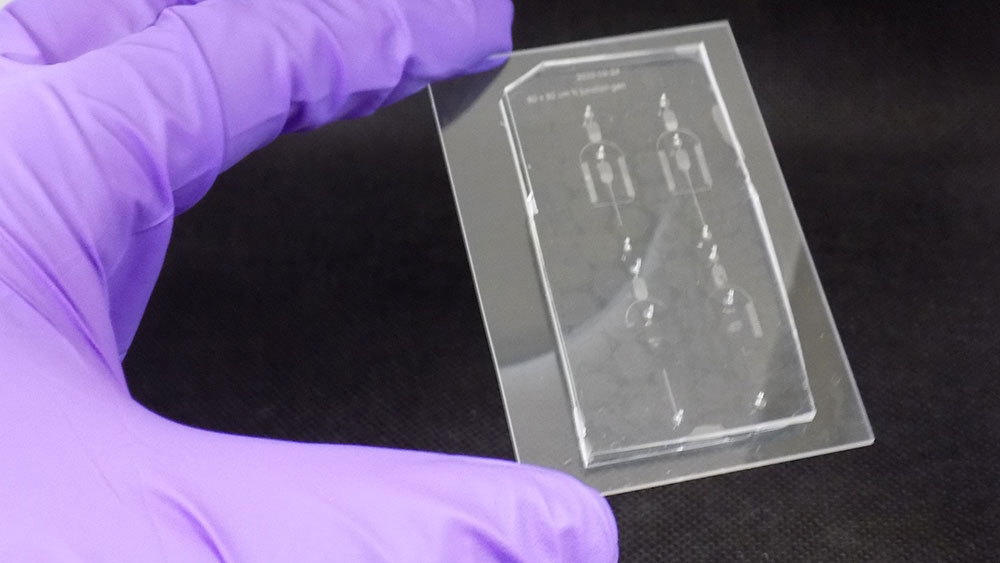
Synthetic biology is an interdisciplinary field of study that applies engineering principles to biology and enables the engineering of microorganisms to have new functions and produce new materials. Through this, researchers can solve real problems faced by society, including those in the areas of medicine, agriculture and national defense, to name a few. But this technique has only been applied to a very limited number of well-known laboratory microorganisms — until now.
Dr. Arum Han, Presidential Impact Fellow and professor in the Department of Electrical and Computer Engineering at Texas A&M University, and Dr. Jose Wippold and Dr. Bryn Adams with the U.S. Army Combat Capabilities Development Command (DEVCOM) Army Research Laboratory (ARL), collaborated to develop a device that accomplishes a task never done before — the automation of DNA transfer into a broad range of synthetic biology host cells, or chassis, using high-throughput microfluidics, allowing for a large number of experiments to be conducted in a very short time.
Their technology, the DNA ENhanced TRAnsfer Platform (DNA ENTRAP), is a microfluidic device that leverages a cell-to-cell DNA transfer tool, XPORT, previously developed through a collaboration between the Massachusetts Institute of Technology and ARL. Texas A&M and ARL then took the strategy and designed, developed and tested a microfluidic device able to automate the steps needed to achieve XPORT DNA transfer. The device can enhance and screen for efficient DNA transfer between cells, ultimately making high-throughput genetic modification possible in a variety of organisms outside of the usual laboratory strains.
The collaborative project with the Army Research Laboratory allows us to apply synthetic biology techniques to this extremely diverse environmental microbes, opening up new ways of harnessing the power of microbes from nature.
Han explained that harnessing the power of these diverse environmental microorganisms is of high interest to the military because they have so many different and unique functions that are currently untapped. While these microorganisms are conventionally very difficult to engineer, the ENTRAP device provides the capability to readily engineer these natural microorganisms, allowing synthetic biology techniques to be applied to the vast and diverse natural microorganisms — enabling the agile development and manufacturing of new materials.
“Microbes in the environment are extremely diverse, where we know less than 1% of these diverse microbes, and thus provides a rich source of new functions and materials,” Han said. “The collaborative project with the Army Research Laboratory allows us to apply synthetic biology techniques to this extremely diverse environmental microbes, opening up new ways of harnessing the power of microbes from nature.”
DNA ENTRAP directly addresses the need for high-throughput, reliable, accurate and automatic systems that can be employed to streamline the labor-intensive and inefficient genetic modification processes into a rapid discovery engine. The end result is a unique system that overcomes the time-consuming and labor-intensive process currently being used while also enabling multi-parameter adjustments and screening of cell-to-cell DNA transfer conditions and their outcomes.
One of the enabling technologies to achieve high-throughput screening is microfluidics — and its subset, droplet microfluidics — which enables researchers to study hundreds to thousands of experiments per second, examined simultaneously through the use of microdroplets. Picture a bottle of oil and water that has been shaken up. Each droplet of water bouncing around in the oil would be a test event.
“You can imagine the physical time it takes to do something on a benchtop in the lab, with the movement of a hand, is on the order of maybe 10 seconds per action with a lag time between each action,” Wippold said. “The automated nature of microfluidics enables up to thousands of these actions per second. The ability to massively scale up this process and allow us to do hundreds of thousands of different experiments in one run is just game-changing,” Wippold said.
The droplet microfluidic system within the DNA ENTRAP device is composed of a series of separate but interconnected microfluidic liquid handling functions to accomplish this rapid direct cell to cell DNA transfer.
Further, the number of each cell type (DNA donor and receiver cells) within the droplet, co-cultivation conditions and size of the droplet (thus the average distance between the cells) can all be controlled with high accuracy, enabling the rapid identification of the conditions and/or cell strains that show the best DNA transfer efficiencies.
Wippold explained that the team expects the amount of time saved to be over 6,000-fold compared to a conventional assay and a corresponding reagent consumption saving of at least 100-fold.
“For example, testing a library of 1 million DNA donor cells against a novel host cell (the cell receiving DNA or other genetic material) under a single condition through conventional means will take an estimated 650 months,” Wippold said. “In comparison, running such a library through the invented droplet microfluidic platform will be accomplished within three days.”